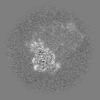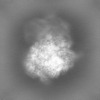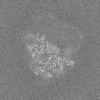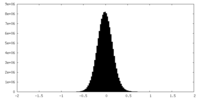[English] 日本語
 Yorodumi
Yorodumi- EMDB-43970: Non-translating Schizosaccharomyces pombe ribosome large subunit -
+ Open data
Open data
- Basic information
Basic information
| Entry |  | |||||||||
|---|---|---|---|---|---|---|---|---|---|---|
| Title | Non-translating Schizosaccharomyces pombe ribosome large subunit | |||||||||
 Map data Map data | ||||||||||
 Sample Sample |
| |||||||||
 Keywords Keywords | Ribosome / Schizosaccharomyces pombe / protein synthesis / S. pombe / TRANSLATION | |||||||||
| Biological species |  | |||||||||
| Method | single particle reconstruction / cryo EM / Resolution: 2.44 Å | |||||||||
 Authors Authors | Gluc M / Gemin O / Purdy M / Mattei S / Jomaa A | |||||||||
| Funding support |  United States, United States,  Germany, 2 items Germany, 2 items
| |||||||||
 Citation Citation |  Journal: Nat Commun / Year: 2024 Journal: Nat Commun / Year: 2024Title: Ribosomes hibernate on mitochondria during cellular stress. Authors: Olivier Gemin / Maciej Gluc / Higor Rosa / Michael Purdy / Moritz Niemann / Yelena Peskova / Simone Mattei / Ahmad Jomaa /   Abstract: Cell survival under nutrient-deprived conditions relies on cells' ability to adapt their organelles and rewire their metabolic pathways. In yeast, glucose depletion induces a stress response mediated ...Cell survival under nutrient-deprived conditions relies on cells' ability to adapt their organelles and rewire their metabolic pathways. In yeast, glucose depletion induces a stress response mediated by mitochondrial fragmentation and sequestration of cytosolic ribosomes on mitochondria. This cellular adaptation promotes survival under harsh environmental conditions; however, the underlying mechanism of this response remains unknown. Here, we demonstrate that upon glucose depletion protein synthesis is halted. Cryo-electron microscopy structure of the ribosomes show that they are devoid of both tRNA and mRNA, and a subset of the particles depicted a conformational change in rRNA H69 that could prevent tRNA binding. Our in situ structural analyses reveal that the hibernating ribosomes tether to fragmented mitochondria and establish eukaryotic-specific, higher-order storage structures by assembling into oligomeric arrays on the mitochondrial surface. Notably, we show that hibernating ribosomes exclusively bind to the outer mitochondrial membrane via the small ribosomal subunit during cellular stress. We identify the ribosomal protein Cpc2/RACK1 as the molecule mediating ribosomal tethering to mitochondria. This study unveils the molecular mechanism connecting mitochondrial stress with the shutdown of protein synthesis and broadens our understanding of cellular responses to nutrient scarcity and cell quiescence. | |||||||||
| History |
|
- Structure visualization
Structure visualization
| Supplemental images |
|---|
- Downloads & links
Downloads & links
-EMDB archive
| Map data |  emd_43970.map.gz emd_43970.map.gz | 483.9 MB |  EMDB map data format EMDB map data format | |
|---|---|---|---|---|
| Header (meta data) |  emd-43970-v30.xml emd-43970-v30.xml emd-43970.xml emd-43970.xml | 14.3 KB 14.3 KB | Display Display |  EMDB header EMDB header |
| Images |  emd_43970.png emd_43970.png | 81.9 KB | ||
| Filedesc metadata |  emd-43970.cif.gz emd-43970.cif.gz | 4.3 KB | ||
| Others |  emd_43970_half_map_1.map.gz emd_43970_half_map_1.map.gz emd_43970_half_map_2.map.gz emd_43970_half_map_2.map.gz | 474.9 MB 474.9 MB | ||
| Archive directory |  http://ftp.pdbj.org/pub/emdb/structures/EMD-43970 http://ftp.pdbj.org/pub/emdb/structures/EMD-43970 ftp://ftp.pdbj.org/pub/emdb/structures/EMD-43970 ftp://ftp.pdbj.org/pub/emdb/structures/EMD-43970 | HTTPS FTP |
-Validation report
| Summary document |  emd_43970_validation.pdf.gz emd_43970_validation.pdf.gz | 1.3 MB | Display |  EMDB validaton report EMDB validaton report |
|---|---|---|---|---|
| Full document |  emd_43970_full_validation.pdf.gz emd_43970_full_validation.pdf.gz | 1.3 MB | Display | |
| Data in XML |  emd_43970_validation.xml.gz emd_43970_validation.xml.gz | 18.8 KB | Display | |
| Data in CIF |  emd_43970_validation.cif.gz emd_43970_validation.cif.gz | 22.4 KB | Display | |
| Arichive directory |  https://ftp.pdbj.org/pub/emdb/validation_reports/EMD-43970 https://ftp.pdbj.org/pub/emdb/validation_reports/EMD-43970 ftp://ftp.pdbj.org/pub/emdb/validation_reports/EMD-43970 ftp://ftp.pdbj.org/pub/emdb/validation_reports/EMD-43970 | HTTPS FTP |
-Related structure data
- Links
Links
| EMDB pages |  EMDB (EBI/PDBe) / EMDB (EBI/PDBe) /  EMDataResource EMDataResource |
|---|
- Map
Map
| File |  Download / File: emd_43970.map.gz / Format: CCP4 / Size: 512 MB / Type: IMAGE STORED AS FLOATING POINT NUMBER (4 BYTES) Download / File: emd_43970.map.gz / Format: CCP4 / Size: 512 MB / Type: IMAGE STORED AS FLOATING POINT NUMBER (4 BYTES) | ||||||||||||||||||||||||||||||||||||
|---|---|---|---|---|---|---|---|---|---|---|---|---|---|---|---|---|---|---|---|---|---|---|---|---|---|---|---|---|---|---|---|---|---|---|---|---|---|
| Projections & slices | Image control
Images are generated by Spider. | ||||||||||||||||||||||||||||||||||||
| Voxel size | X=Y=Z: 0.83 Å | ||||||||||||||||||||||||||||||||||||
| Density |
| ||||||||||||||||||||||||||||||||||||
| Symmetry | Space group: 1 | ||||||||||||||||||||||||||||||||||||
| Details | EMDB XML:
|
-Supplemental data
-Half map: #1
| File | emd_43970_half_map_1.map | ||||||||||||
|---|---|---|---|---|---|---|---|---|---|---|---|---|---|
| Projections & Slices |
| ||||||||||||
| Density Histograms |
-Half map: #2
| File | emd_43970_half_map_2.map | ||||||||||||
|---|---|---|---|---|---|---|---|---|---|---|---|---|---|
| Projections & Slices |
| ||||||||||||
| Density Histograms |
- Sample components
Sample components
-Entire : Non-translating S. pombe ribosome large subunit
| Entire | Name: Non-translating S. pombe ribosome large subunit |
|---|---|
| Components |
|
-Supramolecule #1: Non-translating S. pombe ribosome large subunit
| Supramolecule | Name: Non-translating S. pombe ribosome large subunit / type: complex / ID: 1 / Parent: 0 |
|---|---|
| Source (natural) | Organism:  |
| Molecular weight | Theoretical: 3.5 MDa |
-Experimental details
-Structure determination
| Method | cryo EM |
|---|---|
 Processing Processing | single particle reconstruction |
| Aggregation state | particle |
- Sample preparation
Sample preparation
| Concentration | 0.25 mg/mL |
|---|---|
| Buffer | pH: 7.4 |
| Grid | Model: Quantifoil R2/1 / Material: COPPER / Support film - Material: CARBON / Support film - topology: CONTINUOUS / Support film - Film thickness: 0.2 / Pretreatment - Type: GLOW DISCHARGE / Pretreatment - Time: 15 sec. |
| Vitrification | Cryogen name: ETHANE / Chamber humidity: 100 % / Chamber temperature: 277 K / Instrument: FEI VITROBOT MARK IV |
- Electron microscopy
Electron microscopy
| Microscope | FEI TITAN KRIOS |
|---|---|
| Image recording | Film or detector model: GATAN K3 BIOQUANTUM (6k x 4k) / Average electron dose: 50.0 e/Å2 |
| Electron beam | Acceleration voltage: 300 kV / Electron source:  FIELD EMISSION GUN FIELD EMISSION GUN |
| Electron optics | Illumination mode: FLOOD BEAM / Imaging mode: BRIGHT FIELD / Nominal defocus max: 1.6 µm / Nominal defocus min: 0.6 µm |
| Sample stage | Specimen holder model: FEI TITAN KRIOS AUTOGRID HOLDER / Cooling holder cryogen: NITROGEN |
| Experimental equipment |  Model: Titan Krios / Image courtesy: FEI Company |
- Image processing
Image processing
| Startup model | Type of model: OTHER / Details: Ab initio |
|---|---|
| Final reconstruction | Algorithm: BACK PROJECTION / Resolution.type: BY AUTHOR / Resolution: 2.44 Å / Resolution method: FSC 0.143 CUT-OFF / Number images used: 73376 |
| Initial angle assignment | Type: PROJECTION MATCHING |
| Final angle assignment | Type: PROJECTION MATCHING |
-Atomic model buiding 1
| Refinement | Space: REAL / Protocol: AB INITIO MODEL |
|---|
 Movie
Movie Controller
Controller















 Z (Sec.)
Z (Sec.) Y (Row.)
Y (Row.) X (Col.)
X (Col.)




































